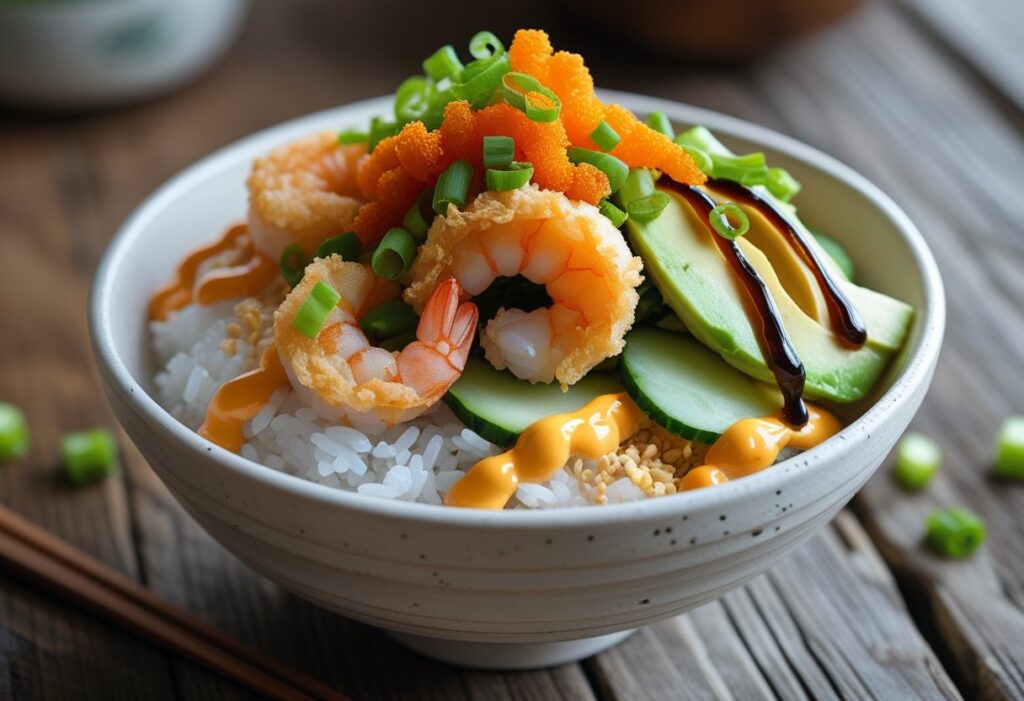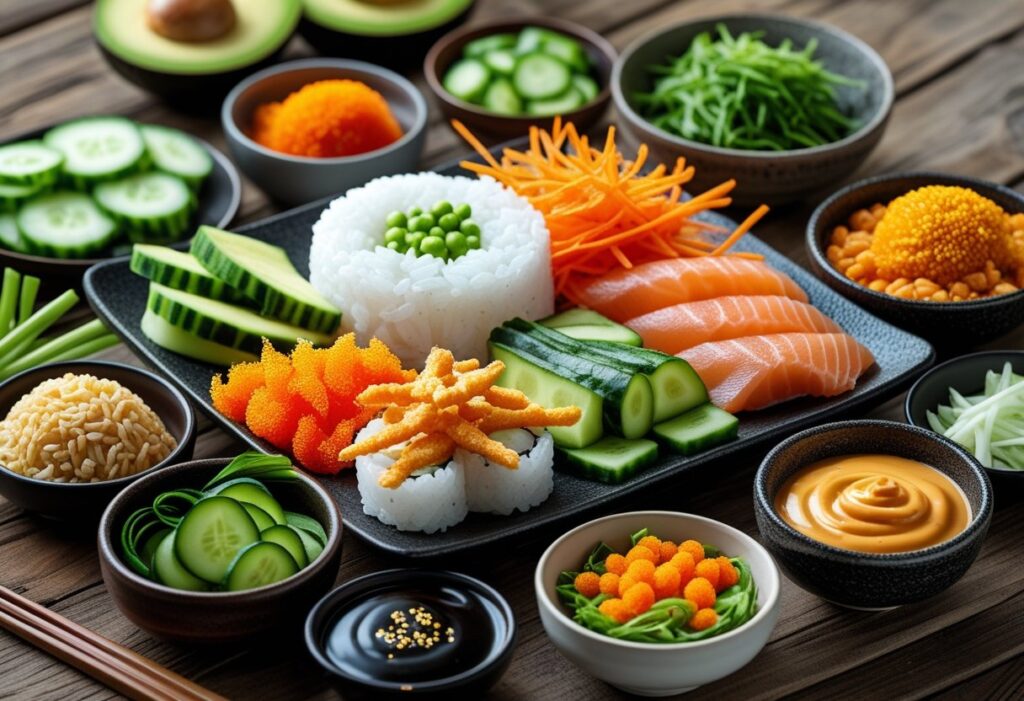The Best Fluffy Pancakes recipe you will fall in love with. Full of tips and tricks to help you make the best pancakes.
I’ve been making crunch roll sushi bowls for years, and they’ve become one of my go-to meals when I want all the flavors of sushi without the rolling technique. A crunch roll sushi bowl contains all the same ingredients as a traditional crunch roll – imitation crab, avocado, cucumber, and crispy toppings – but served over rice in an easy-to-eat bowl format.

What makes these bowls special is how they capture the essence of popular crunch roll sushi while being much simpler to prepare at home. The key is getting that perfect balance of textures, from creamy avocado to crunchy panko breadcrumbs, all tied together with savory eel sauce and spicy mayo.
I’ll walk you through everything you need to know about making these bowls, from understanding the core ingredients to creating your own variations. Whether you’re new to sushi bowls or looking to perfect your technique, this guide covers the essential steps and creative options that make crunch roll sushi bowls such a satisfying meal choice.
What Is a Crunch Roll Sushi Bowl?
A crunch roll sushi bowl takes the popular crunch roll sushi and transforms it into a deconstructed bowl format. This easy-to-make bowl combines fluffy rice with diced imitation crab, fresh cucumber, creamy avocado, and cilantro, topped with crispy panko breadcrumbs and drizzled with signature sauces.
Key Ingredients and Flavor Profile

A great crunch roll sushi bowl relies on three things: balanced textures, fresh ingredients, and bold sauces.
-
Rice base: Short-grain sushi rice (seasoned with rice vinegar, sugar, and salt) for sticky, authentic texture.
-
Protein: Sweet imitation crab is classic, but shrimp tempura, salmon, or tofu are excellent swaps.
-
Vegetables: Crisp cucumber, creamy avocado, and fresh cilantro brighten every bite.
-
Crunch element: Toasted panko breadcrumbs or tempura flakes for that signature texture.
-
Sauces: Eel sauce for sweet-savory depth, spicy mayo for creamy heat.
-
Garnishes: Sesame seeds, thin strips of nori, or tobiko (fish roe) for color and authentic flair.
Step by Step-How to Make a Crunch Roll Sushi Bowl at Home
1. Prepare the Rice Base
-
Rinse 3 cups short-grain sushi rice until water runs clear to remove excess starch.
-
Cook using a 1:1 to 1:1.2 rice-to-water ratio (adjust for your rice cooker).
-
While still warm, fold in a seasoning mixture:
-
2 Tbsp rice vinegar
-
1 Tbsp sugar
-
½ tsp salt
-
This creates authentic sushi rice flavor with the perfect sticky texture.
2. Make the Signature Sauces
-
Eel Sauce (sweet-savory glaze)
Simmer equal parts soy sauce, sugar, and mirin (¼ cup each) for 5–7 minutes until syrupy. -
Spicy Mayo (creamy heat)
Mix ¼ cup mayonnaise with 1 Tbsp sriracha (adjust heat to taste).
Store sauces separately in airtight containers for up to 2 weeks (eel sauce) and 1 week (spicy mayo).
3. Toast the Panko Breadcrumbs
-
Heat ¼ cup olive oil in a skillet.
-
Add 1 cup panko breadcrumbs and stir constantly for 3–5 minutes until golden brown.
-
Remove immediately to paper towels to cool.
These crunchy breadcrumbs are what set this bowl apart from other sushi variations.
4. Assemble the Bowl
-
Spoon seasoned rice into each serving bowl.
-
Arrange diced imitation crab (8 oz), avocado (1 large), and cucumber (1 cup) in neat sections.
-
Drizzle eel sauce and spicy mayo generously across the toppings.
-
Sprinkle toasted panko over the entire bowl for crunch.
-
Add optional garnishes like cilantro, sesame seeds, or nori strips.
Serve immediately to preserve the contrast of warm rice, cold vegetables, and crispy topping.
Customizations and Variations
Protein Swaps
-
Seafood: Shrimp tempura, cooked salmon, real crab meat, spicy tuna
-
Vegetarian: Crispy tofu, tempura sweet potato, shiitake mushrooms
-
Vegan: Marinated tofu, roasted vegetables, seasoned chickpeas
Base Options
-
White sushi rice for traditional texture
-
Brown rice for extra fiber and a nutty taste
-
Cauliflower rice for low-carb or keto diets
Sauce Combinations
-
Classic: Eel sauce + spicy mayo
-
Spicy: Soy sauce + sriracha + sesame oil
-
Tangy: Ponzu sauce + sesame seeds
-
Mild: Regular mayo + rice vinegar
Meal Prep and Storage Tips
-
Rice: Store cooked rice in an airtight container for 3–4 days. Add a splash of water when reheating.
-
Vegetables: Store diced cucumbers in a paper-towel-lined container (2–3 days). Prepare avocado fresh to avoid browning or coat in lemon juice if storing short term.
-
Sauces: Keep sauces separate and drizzle only at serving time to maintain freshness.
-
Crunch elements: Store toasted panko in a sealed jar at room temperature to keep them crispy.
Pro tip: Assemble bowls just before eating to preserve texture and color.
Why Crunch Roll Sushi Bowls Are So Popular
-
Faster than making sushi rolls (no rolling mat required)
-
Endless customization to suit dietary needs
-
Safe for people avoiding raw fish (all ingredients are cooked)
-
Perfect for meal prep when components are stored separately
-
Restaurant-quality flavor at home with minimal effort
Quick Recipe Reference Table
| Component | Amount (per 4 servings) | Notes |
|---|---|---|
| Sushi rice | 3 cups uncooked | Season with vinegar mix |
| Imitation crab | 8 oz diced | Swap with shrimp tempura |
| Avocado | 1 large diced | Add lime to prevent browning |
| Cucumber | 1 cup diced | Persian or English preferred |
| Toasted panko | 1 cup | Toast in ¼ cup olive oil |
| Eel sauce | ~½ cup | Simmer soy, sugar, mirin |
| Spicy mayo | ~¼ cup | Mayo + sriracha to taste |
| Garnishes | Cilantro, sesame seeds, nori | Optional but recommended |
How to Make a Crunch Roll Sushi Bowl at Home
Making a crunch roll sushi bowl requires properly seasoned sushi rice, fresh ingredients like imitation crab and avocado, homemade eel sauce and spicy mayo, plus golden toasted panko for that signature crunch. The key is preparing each component separately before assembling into colorful, restaurant-quality bowls.
Preparing the Rice Base
I always start with sushi rice because it needs the most time to cook and cool. Short-grain sushi rice works best for its sticky texture that holds the bowl together.
Rinse 3 cups of uncooked sushi rice under cold water until the water runs clear. This removes excess starch. Cook the rice according to package directions, typically using a 1:1 or 1:1.2 rice-to-water ratio.
While the rice is still warm, I fold in seasoning made from rice vinegar, sugar, and salt. Mix 2 tablespoons rice vinegar with 1 tablespoon sugar and ½ teaspoon salt until dissolved.
Gently fold this mixture into the cooked rice using a wooden spoon. The rice should be slightly warm when serving, not hot or cold.
Brown rice can substitute sushi rice but creates a different texture and nutty flavor. A rice cooker makes this process easier and more consistent.
Assembling Flavors and Textures
The protein and vegetables create layers of flavor and texture in each bowl. I use 8 oz of imitation crab meat, dicing it into bite-sized pieces for easy eating.
Avocado adds creaminess – I dice one large ripe avocado just before serving to prevent browning. Fresh cucumber provides crisp contrast when finely diced.
Fresh cilantro brightens the bowl with its herbal notes. I roughly chop ¼ cup and sprinkle it over other ingredients.
For extra protein variety, shrimp tempura works well instead of imitation crab. The crispy tempura coating adds more crunch to complement the panko.
Pickled ginger and sesame seeds make excellent garnishes. Thin strips of nori seaweed can be scattered on top for authentic sushi flavor.
Crafting Signature Sauces
Two sauces define the crunch roll flavor: eel sauce and spicy mayo. I make both from scratch for better taste control.
For eel sauce, combine ¼ cup soy sauce, ¼ cup sugar, and 3 tablespoons mirin in a small saucepan. Simmer over medium heat for 5-7 minutes until slightly thickened.
The sauce coats the back of a spoon when ready. It thickens more as it cools to a syrupy consistency.
Spicy mayo requires ¼ cup mayonnaise mixed with 1 tablespoon sriracha. I adjust the sriracha amount based on heat preference.
Both sauces store well in the refrigerator. The homemade eel sauce recipe keeps for up to 2 weeks in airtight containers.
Layering and Presentation Tips
The final assembly creates visual appeal and maintains texture contrasts. I divide seasoned rice evenly among 4-5 bowls as the foundation layer.
Toasted panko provides the signature crunch element. Heat ¼ cup olive oil in a skillet and toast 1 cup panko breadcrumbs for 3-5 minutes until golden brown.
Stir constantly to prevent burning. Transfer immediately to paper towels to drain excess oil and maintain crispiness.
Arrange diced cucumber, avocado, and imitation crab attractively over the rice in separate sections. This creates color contrast and lets diners taste individual components.
Drizzle both sauces generously over the toppings – don’t be conservative with the sauces. Finish with a generous sprinkle of crispy toasted panko and optional sesame seeds.
Serve immediately after assembly to preserve the panko’s crunch and avocado’s freshness.
Customizations, Variations, and Serving Suggestions
You can easily adapt this crunch roll sushi bowl to match your dietary needs and taste preferences. I’ll show you how to swap proteins, change flavors, and keep your bowls fresh for meal prep.
Dietary Adaptations and Alternative Proteins
I recommend swapping imitation crab for cooked shrimp, salmon, or tuna if you want real seafood. For vegetarian options, I use crispy tofu, tempura vegetables, or marinated mushrooms.
Protein Options:
- Seafood: Cooked shrimp, salmon, crab meat, spicy tuna
- Vegetarian: Crispy tofu, tempura sweet potato, shiitake mushrooms
- Vegan: Marinated tofu, roasted vegetables, seasoned chickpeas
Brown rice works perfectly as a healthier base instead of white rice. I also use cauliflower rice for low-carb diets.
For gluten-free bowls, I check that my soy sauce and eel sauce are gluten-free. Many brands now offer tamari as a gluten-free soy sauce alternative.
Flavor Variations and Sauce Swaps
I love experimenting with different sauce combinations to change the flavor profile. Spicy mayo made with sriracha gives heat, while eel sauce adds sweetness.
Sauce Combinations:
- Classic: Spicy mayo + eel sauce
- Spicy: Sriracha + soy sauce + sesame oil
- Mild: Regular mayo + rice vinegar
- Tangy: Ponzu sauce + sesame seeds
I add pickled ginger for a sharp, clean taste that cuts through rich flavors. Fresh cilantro brightens the entire bowl.
For extra crunch, I sprinkle toasted sesame seeds or crushed nori sheets on top. These add nutty flavors and authentic sushi taste.
Storage, Meal Prep, and Freshness Tips
I prep components separately to keep everything fresh. Rice stays good for 3-4 days in the fridge, while cut vegetables last 2-3 days.
Meal Prep Storage:
- Rice: Store covered, reheat with splash of water
- Avocado: Add lemon juice to prevent browning
- Cucumber: Keep in airtight container with paper towel
- Sauces: Store separately, add when serving
I assemble bowls right before eating to maintain the best texture. The crispy elements stay crunchy, and avocado doesn’t get mushy.
For best results, I bring refrigerated components to room temperature before serving. This helps the flavors blend better than eating everything cold.
How Crunch Roll Sushi Bowls Compare to Traditional Sushi Rolls
| Feature | Traditional Crunch Roll | Crunch Roll Sushi Bowl |
|---|---|---|
| Assembly | Rolled in nori sheets | Layered over rice in a bowl |
| Skill level | Requires rolling technique | Beginner-friendly |
| Protein options | Imitation crab or tempura shrimp | Flexible: crab, shrimp, salmon, tofu |
| Texture | Crunch inside the roll | Visible, more pronounced crunch on top |
| Sauces | Inside or drizzled lightly | Heavier drizzle for more flavor impact |
| Meal prep suitability | Limited (rolls dry out fast) | Excellent when stored separately |




